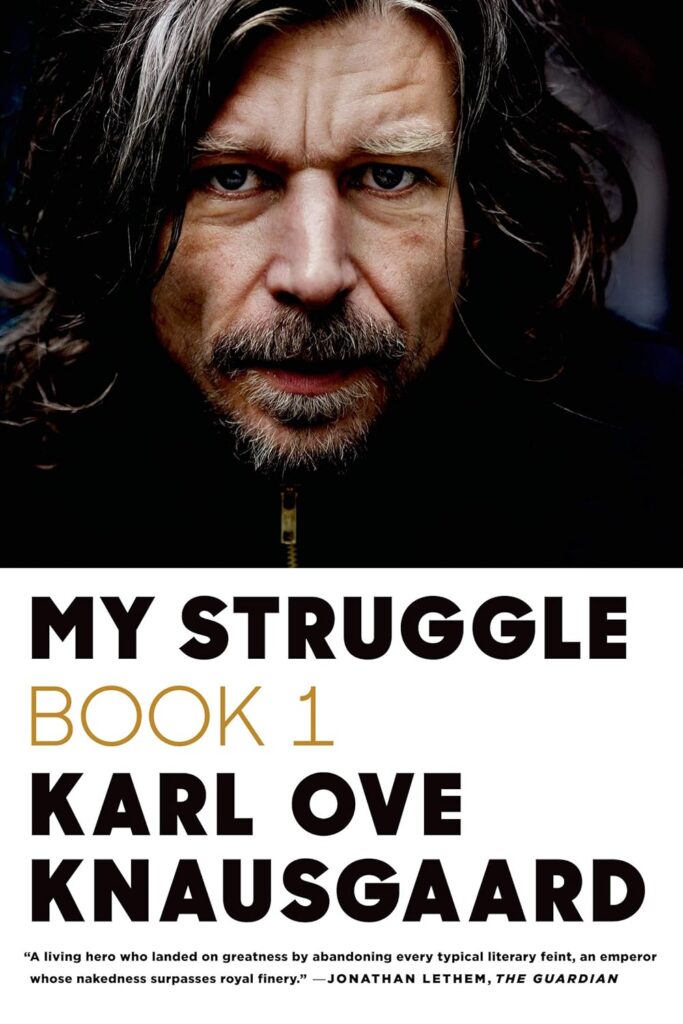Norwegian writer Karl Ove Knausgaard was apparently all the rage a few years ago, with his multi-volume series of novels under the aegis of “My Struggle.” To date, six volumes has been published in this series. He’s also written other books, but is best known for the autobiographical series of books under the heading, My Struggle.
Even as a (former) Norwegian, I hesitated buying/reading his books. He’s too contemporary, too fashionable, I thought, each time I came across his name.
Still, someone I know kept asking me every time we met (not very often, but maybe every two years) whether I’d read his books. I guess that, as a Norwegian, it was somehow assumed that I would have read them. Each time, I replied that, “No, I haven’t read any of his books.” It’s not that I haven’t seen his books in bookstores., or been aware of him. The books were there, though not always in the right order, when I I saw them. Still, I hesitated. Maybe I didn’t like his international success (compared to other Norwegian writers that I thought deserved success). Maybe there were other reasons; the book title hewed too closely to another, more infamous, German title, for one.
Recently, however, I came across two of Knausgaard’s books in a used bookstore, and thought, “Why not?” So, I bought them. One of these books was the first volume in his “My Struggle” series. The other, called Winter, was part of another series based around seasons. Knausgaard’s only a couple of years younger than me, yet he’s a prolific and famous author, while I’ve written only some early-draft crime novels. In other words, there is nothing to compare us, unless you contrast success and nothingness. Winter starts with musings on an unknown and future child (he’s apparently not just prolific, but fertile as well). I set this book aside. I might need to find those other season-related books first.

Meanwhile, the first volume of My Struggle begins with Knausgaard musing on death and dead people. This was unexpected, at least to me, as I thought it would start with his own birth. Then again, after talking about dead people and how we treat them. he transitions into a story about himself at the age of eight, having seen a newscast about a Norwegian fishing vessel capsizing, with those on board drowning. He highlights his own reaction to this event, as well as his interactions with his father. That’s as far as I’ve made it at the moment.
The book begins in 1976. Knausgaard was eight years old at that time. In 1976 I was slightly older, about to leave Norway for a second stint in Zambia. I remember this year vividly. At the of age nine in 1976, this might have been was my “starting” moment in terms of memory, more so than at age eight like Knausgaard. So much happened to me in 1976, a major year in my life. Although I also was in Norway at that time, I don’t recall that same shipwreck incident; in my case there were more personal events that I remember (school, location, a first kiss, the apartment, a so-called friend inviting me somewhere and then eating dinner in front of me, as well as many other things that seared into my memory from that year). Maybe, it’s because we didn’t have a TV, maybe it’s because I saw life differently that time. I certainly didn’t think about death then, not for many years. I thought about life, about where I lived, what I did, and what I saw.
Why is the book called “My Struggle?” I don’t know, at least not yet. He seems to to fear his father at that age, something I don’t think I ever experienced. His father seems to come across as strict, almost tyrannical, despite being a teacher. I think my father at that same age was a little distant, but nowhere near the same as Knausgaard’s father. We’re less than two years apart in age (Knausgaard and I), yet so very different. While I bounced between countries and cultures, he existed only in Norway. Having only sampled a few pages, maybe I’m being too judgmental. Again, what’s the struggle? You had a great life, Karl Ove. You didn’t get dragged to a foreign country. You didn’t change your identity. You’re Norwegian, through and through, not someone split between cultures and continents.
Anyway, I guess I need to read more in that book now, to gain a better insight into why he’s famous. Then again, there are five more volumes to dredge through, if I want to know more. I still don’t get it.
